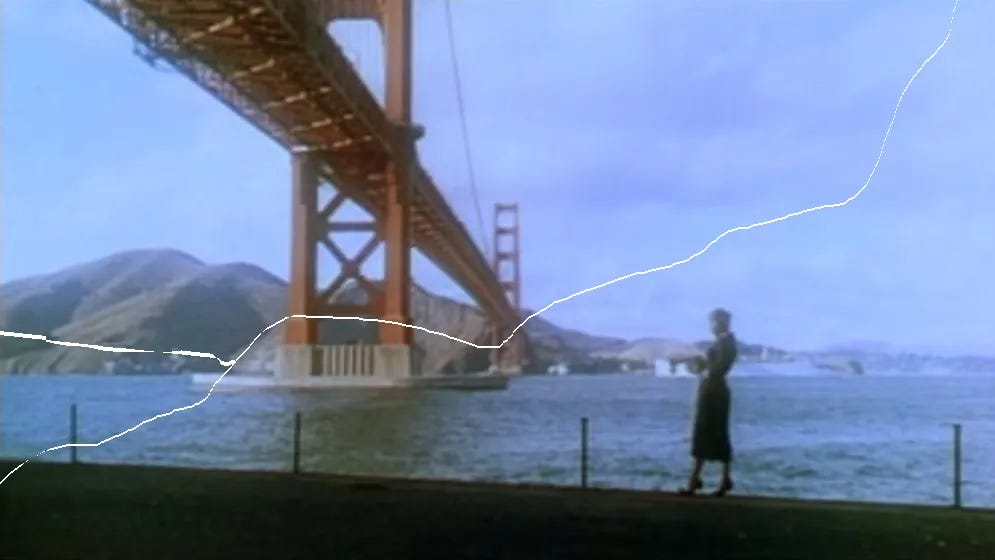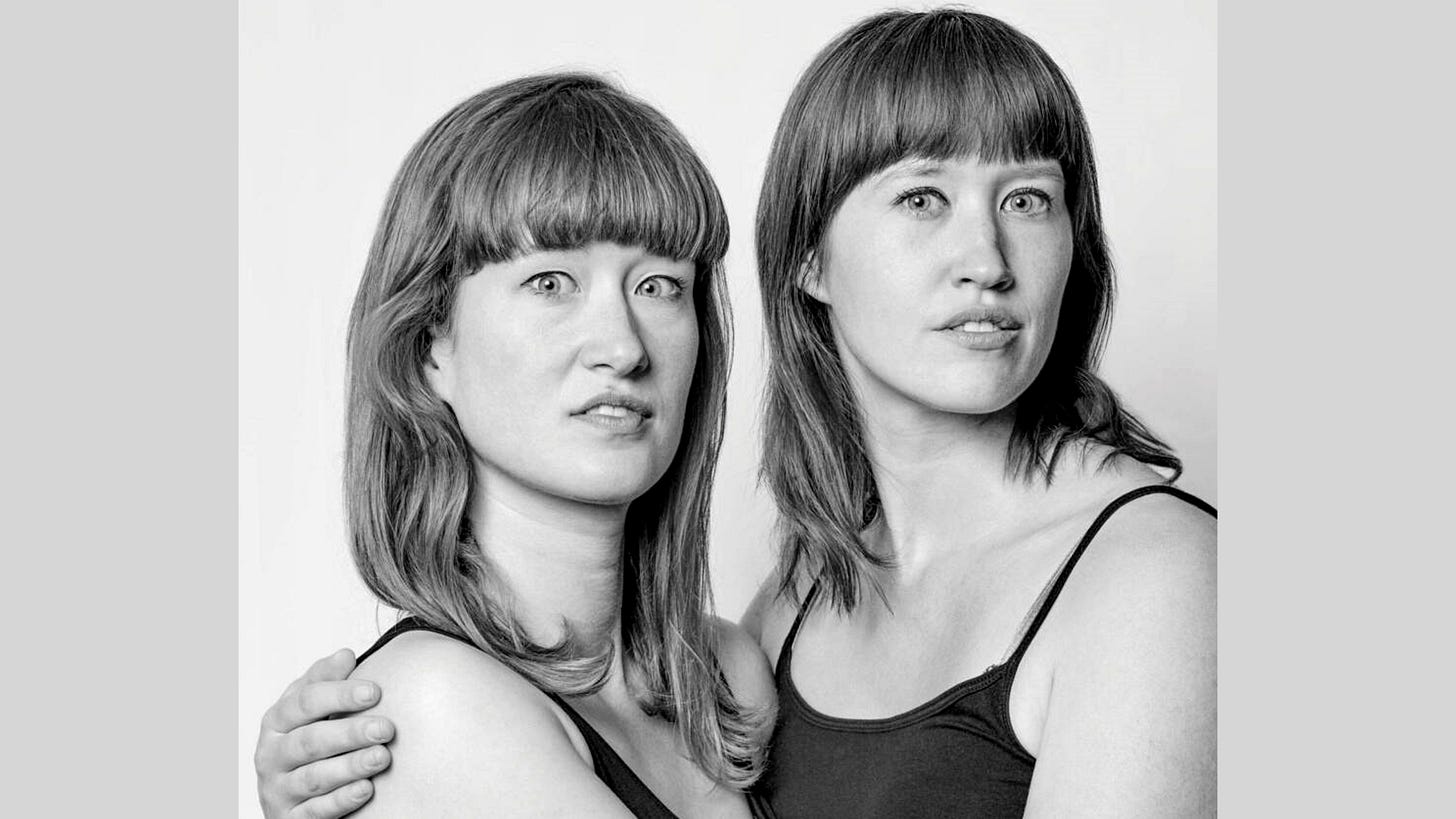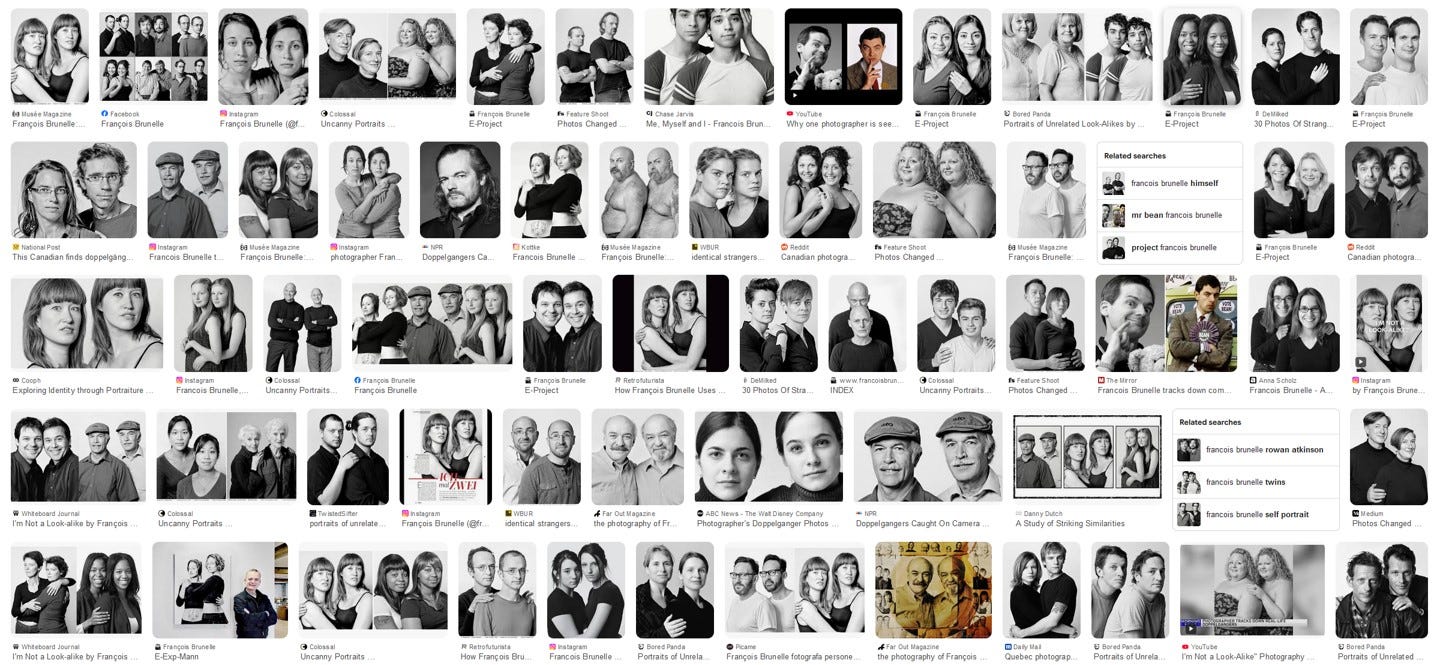The Double World of François Brunelle
Told that he resembled a British entertainer he had never heard of, a Canadian photographer began a 26-year worldwide search for doppelgängers. The results would make a splendid anthology TV series.
A few days back, BASTIAT’S WINDOW featured a post on the ubiquity of rare events: “Why Impossible Things Are Everywhere: A dozen brief musings on the role of mathematics and God in the ubiquity of highly improbable occurrences.” Today’s post describes photographer François Brunelle, who has spent twenty-six years searching the world for one particular variety of improbable occurrence.
STRANGERS ON A TRAIN
There is an eerie, other-worldly beauty to the photograph atop this post. The physical similarities between the two women are almost too precise to be believable. The noses and jaws. The piercing, translucent eyes. The hair styles. The skin tones and arms. The distinctive lips—bottom one protruding slightly, top one pulled upward just a bit, opening between lips revealing identical teeth. Well-defined philtrums (nose-to-lip indentations).
Is this a fabrication, you wonder, generated by Grok or Midjourney? But the hand exhibits none of the missing, extra, or disfigured fingers endemic to generative AI art. No, this is a genuine photo of two women—differing only sightly in height. Identical twins, perhaps? No. Sisters? No. Cousins? No.
In fact, they were total strangers, both Dutch, whose friendship stemmed from a chance meeting on a train between one of the women and an acquaintance of the other. Their portrait is by Canadian photographer François Brunelle, who in 1999 began combing the earth for such doppelgängers and, twenty-six years later, has documented over 250 pairs. Brunelle told their story in an interview with WBUR radio in Boston:
“[I]t's funny because one of them, she was in a train and then she passed by a man on the train. He says, ‘Oh, hello.’ And he called her by the name of the other girl and say, ‘How are you?’ And she said, ‘Do I know you?’ ‘Well, we, we lived together for a few years. Yes, we, you know me.’ She said, ‘I'm sorry, that’s not me.’ And then she asked for the contact of the other girl. And then she got in contact with her. They became friends. And then they wrote to me.”
Not only did they become friends, but, under the collective name “Es and Nes,” they became literary collaborators. Brunelle calls his project, “I’m Not a Look-Alike.” The assemblage below is what you get when you do a Google Image search on “François Brunelle.” Lots more where they came from.
DOUBLE MURDERED AND DOUBLE MURDERER
My wife looked at Brunelle’s work and said, “That would make an incredible TV series.” I sent the idea to a screenwriter we know, but he’s in no position to bring the idea to fruition. Someone should. (I compose music, so I’ll happily write the theme song—a two-part invention, naturally.) For would-be showrunners, two stories especially come to mind—a murder victim and her doppelgänger, and a murderer and his doppelgänger.
The WBUR interviewer told Brunelle:
“It’s been amazing to read how this idea of finding your doppelganger can be used for evil. There’s a woman who searched online for women who look like her because she was trying to fake her own death and get away from a family situation. She found a look-alike and then killed her, so that people would think the body was hers and she could get away.”
(That was Germany’s 2022 “Doppelgänger Murder.” The ruse succeeded briefly—till the murderer/doppelgänger and her boyfriend/accomplice were spotted when they went out for pizza the day after.
While touring the FBI Headquarters in Washington many years ago, I saw the two pairs of photos below in a hallway. In 1903, Will West entered Leavenworth Penitentiary. His Bertillon (anthropometric) measurements, photographs, and name matched those of William West, a convicted murderer. Will West denied being that murderer, saying:
“That’s my picture, but I don’t know where you got it, for I know I have never been here before.”
Prison personnel scoffed till they discovered that William West, the murderer, was still incarcerated at that same facility. The FBI exhibit suggested this case helped sell the idea of fingerprinting as a means of establishing identification.
Our screenwriter friend noted that the late David Lynch had a fascination with doppelgängers. (In Twin Peaks, Agent Cooper encounters a malevolent doppelgänger in the Black Lodge.) He also mentioned Alfred Hitchcock’s Vertigo (which I discussed in “Suspension of Disbelief”) and Denis Villeneuve’s Enemy (which I’ve not seen). The doppelgänger page in Wikipedia tells how the concept has been treated from ancient times to today in mythology, folklore, literature, cinema, and science.

BRUNELLE AND BEAN
The five-minute video above tells the story of Brunelle and his project. In the late 1990s, someone told him that he looked like British comedian Rowan Atkinson (“Mr. Bean”)—whom he had never heard of. Initially, Brunelle didn’t see the resemblance, as he had always thought of himself as looking a bit like “Mr. Dean” (the late actor James Dean). Once the idea of Bean over Dean sank in, he began searching Canada for doppelgängers. As word of the project spread across the internet, doppelgängers began seeking him out. Coincidences multiplied. A male/female couple who look alike. Two doppelgängers born on the same day. Two who married women with the same name. Similar clothing choices. College roommates who were floored when they arrived to share a dorm room.
Brunelle’s photos led to a 2022 genetic study by researchers at Spain’s Josep Carreras Leukaemia Research Institute.
“[W]e have characterized in detail a set of ‘look-alike’ humans, defined by facial recognition algorithms, for their multiomics landscape. We report that these individuals share similar genotypes and differ in their DNA methylation and microbiome landscape. These results not only provide insights about the genetics that determine our face but also might have implications for the establishment of other human anthropometric properties and even personality characteristics.”
With social media and artificial intelligence combing the web, expect far more doppelgängers to connect with one another. Interesting implications for crime and espionage.
MY DOUBLE? YOU DECIDE.
Not long after The Graduate (1967) premiered, people began telling me that I looked like Dustin Hoffman. As I told in a 2023 post, one slightly inebriated socialite in the late 1970s thought I was Dustin Hoffman. At a political banquet, she cornered me and said she was one of my biggest fans. After gushing a bit about “my” work, she asked whether I would sign her program. I opened it and wrote, “To one of my biggest fans. —Bob” and then closed it, handed it back, and watched her stuff it into her purse. Her friends wouldn’t believe whose signature she had obtained when she showed them the next day, she said. I suspect that prediction proved correct.
When I first met my wife, she worked with a man whose daughter had married Hoffman—but they had divorced a few months earlier. Alanna said it probably wasn’t the best time to introduce me to him; we never did meet. As a professor, almost every semester, some grad student would ask on Day One whether anyone had ever mentioned the resemblance; eventually, I assembled the six-photo montage above and began answering the question by saying “no” and then popping the images up on the screen.
SEPARATED AT BIRTH
This is not exactly a story on doppelgängers, but it’s related. A great friend of BASTIAT’S WINDOW sent a heart-warming, gut-wrenching video about a family member of his who discovered at age 54 that she was one-half of a pair of twins separated at birth by an adoption agency conducting an unethical scientific study. As explained by The Atlantic, which produced the video, their reunion, just a few years before one of the two died, resulted from a series of serendipitous events. A documentary, Three Identical Strangers, had told of three triplets similarly separated at birth and later reunited. One of the twins saw the film and recognized the boys’ adoption agency as the same one that had placed her with her adoptive family. She took a DNA test and found that another woman with a close genetic profile had also taken the same test from the same company. The film shows the rest.









I can't stop looking at that first photo! Surreal. And then to read about the chance train meeting makes it even more unbelievable.
I have no doubt that Rod Serling would have crafted a wonderful 30 minute episode from this. "Submitted for your approval....."
I suppose this shows that, given a large enough sample size, there will be duplicates (nearly) of even extremely complicated sequences. The really tricky part is finding them, which the internet is probably making easier.
Another unbelievable part of the article is that the view from that spot at Fort Point hasn't noticeably changed in 65 years, except for the style of the boats in the Bay.